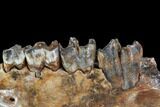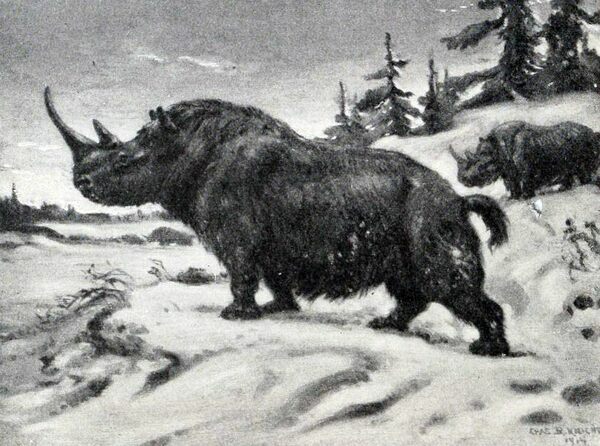This Specimen has been sold.
10.5" Juvenile Woolly Rhino (Coelodonta) Jaw - Pleistocene
This is a rare, 10.5" long, fossil lower jaw of a Late Pleistocene aged Woolly Rhino (Coelodonta antiquitatis). It came from the North Sea, off the coast of the Netherlands. There are four original molars still in place. One aspect that makes this such a rare piece is that it would have come from a very young, juvenile animal.
Comes with a display stand.
Comes with a display stand.
The woolly rhinoceros (Coelodonta antiquitatis) is an extinct species of rhinoceros that was common throughout Europe and northern Asia during the Pleistocene epoch. As the last and most derived member of the Pleistocene rhinoceros lineage, the woolly rhinoceros was well adapted to its environment. Stocky limbs and thick woolly fur made it well suited to the steppe-tundra environment that it lived in.
The wooly rhino grew to 11 feet in length and stood 6 feet at its shoulders. It had a huge pair of horns that grew inline on its snout. The front horn grew to lengths in excess of 3 feet. Like modern rhinos, wooly rhinoceroses had horns composed of keratin. They first appeared in the fossil record 1.8 million years ago and went extinct as recently as 10,000 years ago.
The wooly rhino grew to 11 feet in length and stood 6 feet at its shoulders. It had a huge pair of horns that grew inline on its snout. The front horn grew to lengths in excess of 3 feet. Like modern rhinos, wooly rhinoceroses had horns composed of keratin. They first appeared in the fossil record 1.8 million years ago and went extinct as recently as 10,000 years ago.
These Pleistocene fossils were dredged up by fishing trawlers in the the North Sea between Britain and Denmark. Fishermen routinely find mammoth teeth and many Ice Age fossils in their nets: given the chance that a fossil is accidentally gathered in a net is slim, the sea floor is probably littered with the remains of millions of animals. The cold temperatures and low-oxygen environment of the North Sea have aided in the preservation of these teeth and bones.
While these fossils have been pulled up in nets for more than a century, they used to be frequently discarded. It wasn't until the past two decades that this material has begun to be systematically collected and studied. By recording the locations of their finds and allowing scientists to make observations before the more common material is made available, much has been learned about the fauna that once roamed the land that now lies 30 to 150 feet below the North Sea waters.
You can read more information about this at the following link.
http://www.independent.co.uk/news/science/the-watery-grave-of-europes-monsters-1744973.html
While these fossils have been pulled up in nets for more than a century, they used to be frequently discarded. It wasn't until the past two decades that this material has begun to be systematically collected and studied. By recording the locations of their finds and allowing scientists to make observations before the more common material is made available, much has been learned about the fauna that once roamed the land that now lies 30 to 150 feet below the North Sea waters.
You can read more information about this at the following link.
http://www.independent.co.uk/news/science/the-watery-grave-of-europes-monsters-1744973.html
SPECIES
Coelodonta antiquitatis
LOCATION
North Sea, Doggerland Bank, Netherlands Coast
SIZE
10.5" long
CATEGORY
SUB CATEGORY
ITEM
#87472
We guarantee the authenticity of all of our specimens.
 Reviews
Reviews
















